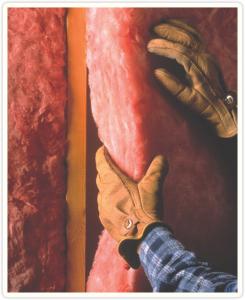
For attic insulation I would recommend either:
- cotton batt or
- blown-in cellulose.
These are both nontoxic, no-VOC, and formaldehyde-free. Both products also have good soundproofing qualities, contain a high amount of recycled material, and are easy to work with.In fact, I installed both in my own house during a recent remodel.
Soy-based spray foam products
There are also fairly new soy-based foam products that can be sprayed on walls or in attics between ceiling joists.
- The main advantage of spray foams is that the foam will expand during installation to fill all cracks and voids to create a continuous air barrier that prevents warm air from leaking out of your house.
- The R-value depends on whether you choose an open-cell or closed-cell foam. (Closed-cell foam's R-value is higher.)
- The manufacturers claim there is no offgassing once the foam dries and that it is mold and mildew resistant.
The main drawback of foam products is that they tend to be very expensive compared to other options; for this reason, my company usually installs cotton or cellulose insulation.
Fiberglass
We avoid fiberglass because of formaldehyde issues and general itchiness, and also because it is difficult to install correctly. (You have to avoid compressing it and be careful to leave no gaps or air-spaces.)
Cotton batts
Cotton batts are available in R-13, R-19, R-21, or R-30 insulation values, in either 16- or 24-inch widths. Cotton batts are made of 85-percent post-industrial recycled natural fibers, mostly ground-up blue jeans.
- Batts are four feet long and can be simply laid between ceiling joists.
- You can do this yourself or you can hire a professional.
Minor disadvantages to cotton batts are that they are slightly harder to cut than fiberglass and the bundles are somewhat bulky because the cotton does not compress much. The cotton batts are slightly oversized compared to standard joist or stud bays so that when stuffed in place they have a good friction-fit and fill the cavities completely with no air gaps.
See Bonded Logic's website for more information.
Cellulose
Blown-in cellulose is an excellent option for an attic because it will fill all the joist spaces completely with very few air gaps. It is also very easy to install a higher thickness for greater R-value.
- Loose cellulose is made of 85-percent recycled material, mostly ground-up newspaper.
- It resists rot and mildew, and is treated with boric acid as a fire retardant.
See the websites of Bonded Logic and the Cellulose Insulation Manufacturers Association for more information. If you want to do the project yourself, Home Depot will loan a blower when you buy a minimum amount of cellulose insulation. However, if you want to install loose cellulose into walls, underfloor areas, or cathedral ceilings, I strongly recommend hiring a licensed professional.
Installation tips
There are a few things to note when insulating an attic. You must not cover up any recessed-can light fixtures unless they are IC rated (IC stands for "insulation contact"). The danger is that the can-light could overheat and cause a fire.
There is a similar fire risk with older houses that have knob-and-tube wiring. Many jurisdictions will not allow knob-and-tube wiring to be covered by any insulation. Your options are to remove the old wiring and replace it with new wiring and lots of junction boxes, or to create an awkward covering system for all the wires.
Another potential problem to avoid is covering up any ventilation openings, especially at the eaves. This can create a variety of overheating or moisture problems, depending on your climate zone. Batts can be held back a bit from any eave vent openings, but if you use cellulose insulation you may have to install baffles to prevent the blown-in insulation from flowing to the edges of the eaves and covering vent openings. If you have lots of eave vents, it may be best to hire an experienced installer and not do it yourself.
Minimum recommended insulation level
In Boulder, CO, R-38 is the minimum insulation level recommended by the U.S. Department of Energy for a ceiling.
In general, higher insulation levels, especially in the ceiling, are your best investment for saving energy (and money in the long run!) and creating comfort in your home.
For more information on insulation, moisture control, and ventilation, consult the DOE's Energy Efficiency and Renewable Energy website.
This article "What is the safest and most effective insulation for our attic crawl space" originally appeared in the USGBC's Green Home Guide - an excellent source for green home expertise, ideas, and connections.
Ian MacLeod is a licensed architect, general contractor, and founder of Berkeley-based MacLeod Design & Construction which specializes in creating beautiful, energy-efficient, and sustainable homes.

